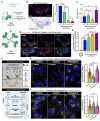Exploration into Galectin-3 Driven Endocytosis and Lattices
- PMID: 39334935
- PMCID: PMC11430376
- DOI: 10.3390/biom14091169
Exploration into Galectin-3 Driven Endocytosis and Lattices
Abstract
Essentially all plasma membrane proteins are glycosylated, and their activity is regulated by tuning their cell surface dynamics. This is achieved by glycan-binding proteins of the galectin family that either retain glycoproteins within lattices or drive their endocytic uptake via the clathrin-independent glycolipid-lectin (GL-Lect) mechanism. Here, we have used immunofluorescence-based assays to analyze how lattice and GL-Lect mechanisms affect the internalization of the cell adhesion and migration glycoprotein α5β1 integrin. In retinal pigment epithelial (RPE-1) cells, internalized α5β1 integrin is found in small peripheral endosomes under unperturbed conditions. Pharmacological compounds were used to competitively inhibit one of the galectin family members, galectin-3 (Gal3), or to inhibit the expression of glycosphingolipids, both of which are the fabric of the GL-Lect mechanism. We found that under acute inhibition conditions, endocytic uptake of α5β1 integrin was strongly reduced, in agreement with previous studies on the GL-Lect driven internalization of the protein. In contrast, upon prolonged inhibitor treatment, the uptake of α5β1 integrin was increased, and the protein was now internalized by alternative pathways into large perinuclear endosomes. Our findings suggest that under these prolonged inhibitor treatment conditions, α5β1 integrin containing galectin lattices are dissociated, leading to an altered endocytic compartmentalization.
Keywords: clathrin; endocytosis; galectin-3; gl-lect hypothesis; glycosphingolipids; lattices; α5β1 integrin.
Conflict of interest statement
Hakon Leffler and Ulf J. Nilsson are shareholders in Galecto Biotech Inc., a company that develops galectin inhibitors. The other authors declare that they have no conflicts of interest with the contents of this article.
Figures








Similar articles
-
Glycolipid-dependent and lectin-driven transcytosis in mouse enterocytes.Commun Biol. 2021 Feb 9;4(1):173. doi: 10.1038/s42003-021-01693-2. Commun Biol. 2021. PMID: 33564097 Free PMC article.
-
Galectin-3 Binding to α5β1 Integrin in Pore Suspended Biomembranes.J Phys Chem B. 2022 Dec 8;126(48):10000-10017. doi: 10.1021/acs.jpcb.2c05717. Epub 2022 Nov 22. J Phys Chem B. 2022. PMID: 36413808 Free PMC article.
-
Endocytic Roles of Glycans on Proteins and Lipids.Cold Spring Harb Perspect Biol. 2024 Jan 2;16(1):a041398. doi: 10.1101/cshperspect.a041398. Cold Spring Harb Perspect Biol. 2024. PMID: 37735065 Review.
-
Dynein functions in galectin-3 mediated processes of clathrin-independent endocytosis.J Biosci. 2024;49:42. J Biosci. 2024. PMID: 38445557
-
Glycosylation and raft endocytosis in cancer.Cancer Metastasis Rev. 2020 Jun;39(2):375-396. doi: 10.1007/s10555-020-09880-z. Cancer Metastasis Rev. 2020. PMID: 32388640 Free PMC article. Review.
References
-
- Varki A., Cummings R.D., Esko J.D., Stanley P., Hart G.W., Aebi M., Mohnen D., Kinoshita T., Packer N.H., Prestegard J.H., et al. Essentials of Glycobiology. Cold Spring Harbor Laboratory Press; Cold Spring Harbor, NY, USA: 2022. Galectins; pp. 491–504. - PubMed
-
- Banfer S., Schneider D., Dewes J., Strauss M.T., Freibert S.A., Heimerl T., Maier U.G., Elsasser H.P., Jungmann R., Jacob R. Molecular mechanism to recruit galectin-3 into multivesicular bodies for polarized exosomal secretion. Proc. Natl. Acad. Sci. USA. 2018;115:E4396–E4405. doi: 10.1073/pnas.1718921115. - DOI - PMC - PubMed
MeSH terms
Substances
Grants and funding
LinkOut - more resources
Full Text Sources

